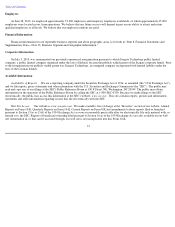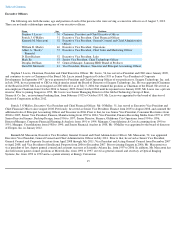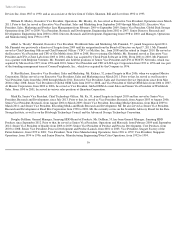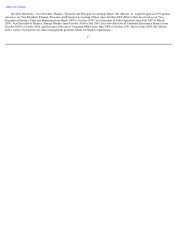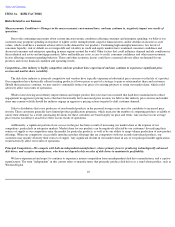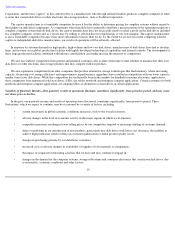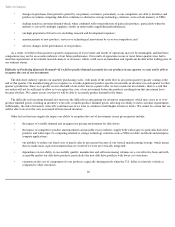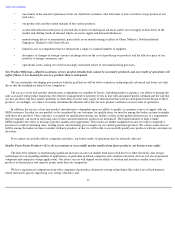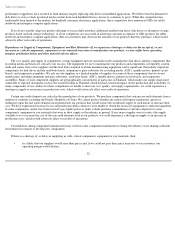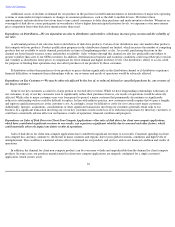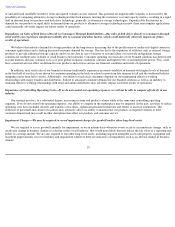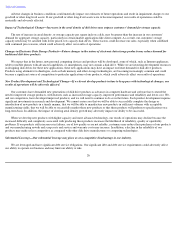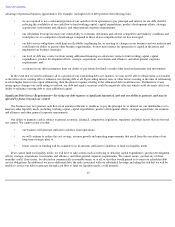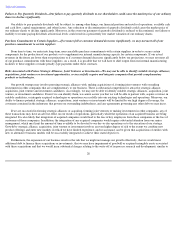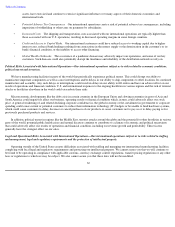Seagate 2012 Annual Report Download - page 26
Download and view the complete annual report
Please find page 26 of the 2012 Seagate annual report below. You can navigate through the pages in the report by either clicking on the pages listed below, or by using the keyword search tool below to find specific information within the annual report.
Table of Contents
• we might have to reengineer some products, which would likely cause production and shipment delays, make the reengineered
products more costly and provide us with a lower rate of return on these products;
• we would likely have to allocate the components we receive to certain of our products and ship less of others, which could reduce
our revenues and could cause us to lose sales to customers who could purchase more of their required products from
manufacturers that either did not experience these shortages or delays or that made different allocations; and
• we might be late in shipping products, causing potential customers to make purchases from our competitors, thus causing our
revenue and operating margin to decline.
We cannot assure you that we will be able to obtain critical components in a timely and economic manner.
Importance of Time
-to-Maturity—Our results of operations may depend on our being among the first-to-
maturity with new product offerings
and achieving sufficient production volume with our new products.
To achieve consistent success with our OEM customers, it is important that we be an early provider of new types of disk drives featuring
leading, high-quality technology and lower per gigabyte storage cost. Historically, our results of operations have substantially depended upon
our ability to be among the first-to-maturity with new product offerings. Our market share and results of operations in the future may be
adversely affected if we fail to:
• consistently maintain our time-to-maturity performance with our new products;
• produce these products in sufficient volume;
• qualify these products with key customers on a timely basis by meeting our customers' performance and quality specifications; or
• achieve acceptable manufacturing yields, quality and costs with these products.
If the delivery of our products is delayed, our OEM customers may use our competitors' products to meet their production requirements. If
the delay of our products causes delivery of those OEMs' computer systems into which our products are integrated to be delayed, consumers and
businesses may purchase comparable products from the OEMs' competitors.
We face the related risk that consumers and businesses may wait to make their purchases if they want to buy a new product that has been
shipped or announced but not yet released. If this were to occur, we may be unable to sell our existing inventory of products that may be less
efficient and cost effective compared to new products. As a result, even if we are among the first-to-maturity with a given product, subsequent
introductions or announcements by our competitors of new products could cause us to lose revenue and not achieve a positive return on our
investment in existing products and inventory.
Industry Demand
—Poor global economic conditions and changes in demand for computer systems and storage subsystems may cause in the
future a decline in demand for our products.
Our disk drives are components in computers, computer systems, storage subsystems and consumer electronics devices. The demand for
these products has been volatile. During times of poor global economic conditions, consumer spending tends to decline and retail demand for
personal computers and consumer electronics devices tends to decrease, as does enterprise demand for computer systems and storage
subsystems. Moreover, unexpected slowdowns in demand for computer systems, storage subsystems or consumer electronics devices generally
cause sharp declines in demand for disk drive products. The decline in consumer spending could have a material adverse effect on demand for
our products and services and on our financial condition and results of operations.
23



